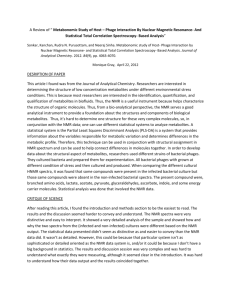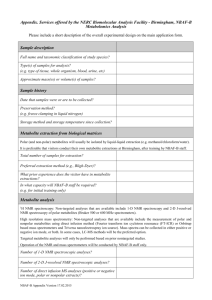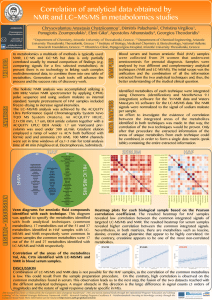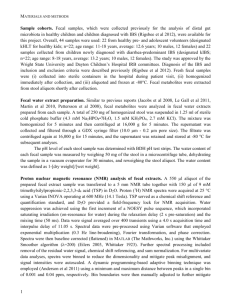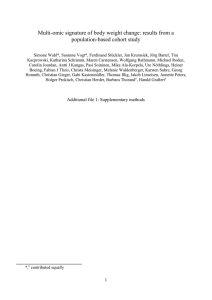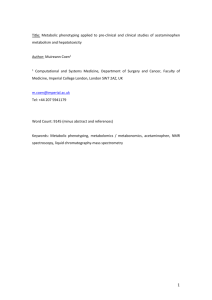Supplementary materials and methods
advertisement
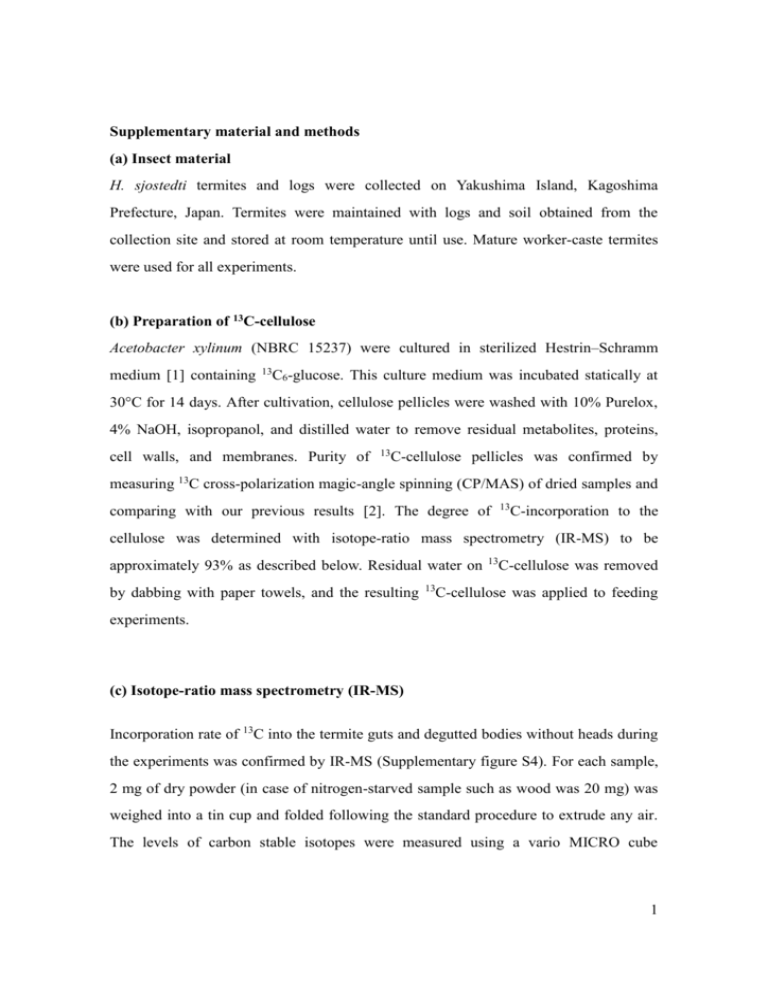
Supplementary material and methods (a) Insect material H. sjostedti termites and logs were collected on Yakushima Island, Kagoshima Prefecture, Japan. Termites were maintained with logs and soil obtained from the collection site and stored at room temperature until use. Mature worker-caste termites were used for all experiments. (b) Preparation of 13C-cellulose Acetobacter xylinum (NBRC 15237) were cultured in sterilized Hestrin–Schramm medium [1] containing 13 C6-glucose. This culture medium was incubated statically at 30°C for 14 days. After cultivation, cellulose pellicles were washed with 10% Purelox, 4% NaOH, isopropanol, and distilled water to remove residual metabolites, proteins, cell walls, and membranes. Purity of 13 C-cellulose pellicles was confirmed by measuring 13C cross-polarization magic-angle spinning (CP/MAS) of dried samples and comparing with our previous results [2]. The degree of 13 C-incorporation to the cellulose was determined with isotope-ratio mass spectrometry (IR-MS) to be approximately 93% as described below. Residual water on by dabbing with paper towels, and the resulting 13 C-cellulose was removed 13 C-cellulose was applied to feeding experiments. (c) Isotope-ratio mass spectrometry (IR-MS) Incorporation rate of 13C into the termite guts and degutted bodies without heads during the experiments was confirmed by IR-MS (Supplementary figure S4). For each sample, 2 mg of dry powder (in case of nitrogen-starved sample such as wood was 20 mg) was weighed into a tin cup and folded following the standard procedure to extrude any air. The levels of carbon stable isotopes were measured using a vario MICRO cube 1 elemental analyzer (Elementar Analytical, Hanau, Germany) connected to an IsoPrime100 gas IR-MS (IsoPrime Ltd, Cheadle, UK). (d) 13C-cellulose feeding experiments Twenty-five termites were maintained in a 100-ml plastic cup with approximately 10 g of 13 C-cellulose for 24 h. Then, 20 termites were randomly selected and dissected to examine foreguts, midguts, and hindguts (Supplementary figure S1). Hindguts were further divided into anterior and posterior portions on dry ice (Supplementary figure S1). Equal numbers (i.e. 20) of termites prior to feeding 13C-cellulose also were dissected as controls. Two replicates of each gut segment were collected in 2-ml microtubes on dry ice. All samples were kept at −80˚C until use. (e) Sample preparation and measurements using 1D and 2D NMR Termite samples stored at −80˚C were freeze-dried and homogenized using an auto-mill (Tokken, Chiba, Japan). Subsequently, 4–10 mg of the freeze-dried tissue samples were extracted with 400–1000 μl phosphate buffer solution (0.1 M K2HPO4/KH2PO4, 0.01% NaN3, pH 7.0), containing 90% D2O and 1 mM sodium 2,2-dimethyl-2-silapentane-5-sulfonate (DSS) at 65°C for 15 min. In addition to metabolites, crude extracts of biological samples generally contain ions and biopolymers that have the potential to cause unpredictable fluctuations in the chemical shifts of metabolites. To ensure the reliability of the NMR detections, we prepared the samples in appropriate dilutions using standards based on our previous method that had fluctuations of biological samples within 0.03 ppm and 0.54 ppm for both 1H and 13C, respectively [3]. After centrifugation, the extracted supernatants were transferred into 5-mm Φ NMR tubes for measurements. All 2D 1H-13C hetero-nuclear single quantum coherence (HSQC) and J-resolved (2D-J) spectra were recorded on a Bruker DRU-700 NMR spectrometer (Bruker Biospin, Rheinstetten, Germany) equipped with a 1H inverse cryogenically cooled probe with a z-axis gradient as previously described [4-6]. 2 In brief, 128 complex f1 (13C) and 1024 complex f2 (1H) points were recorded at 8 scans per f1 increment for 13 C-HSQC measurements. Spectral widths were 7,042 Hz and 9,389 Hz for f1 and f2, respectively. All NMR spectra were processed using NMRPipe [7] and rNMR [8] and were assigned using the SpinAssign program on the PRIMe Website [9]. Intensity values of all metabolite signals were initially normalized using 1 mM DSS. Intensity values of each gut position were then divided by the gut volume (µL) to represent relative intensities per µL of the metabolites (represented as a.u., arbitrary units). The volume of each gut position was obtained by estimating volumes of circular truncated cones by measuring gut diameters (widths) every 500 µm of longitudinal length. The resulted gut volumes were 1.7 ± 0.2 µL (6.3%) for the foregut, 2.0 ± 0.4 µL (7.5%) for the midgut, 16.9 ± 2.4 µL (59.6%) for the anterior hindgut, and 6.9 ± 1.7 µL (26.6%) for the posterior hindgut, respectively (n=10). (f) Data analysis For clustering analyses, metabolites were grouped based on a hierarchical cluster of temporal variation in the signals. Distances among metabolites were evaluated using Euclidean distances after standardization of the data. Average linkage was used as the clustering method. Significance among groups of interest was examined by a multiple response permutation procedure (MRPP) [10] based on 9,999 permutations. For ordination of metabolite groups in each gut regions, Kruskal’s non-metric multidimensional scaling (NMDS) [10, 11] based on distances among metabolites was performed with some modifications. In brief, dissimilarities in the temporal variations of the signals were evaluated using Euclidean distance following standardization. The number of dimensions used in the scaling was K = 2. Scaling was performed using statistical software R. References 1. Hestrin S., Schramm M. 1954 Synthesis of cellulose by Acetobacter xylinum. II. 3 Preparation of freeze-dried cells capable of polymerizing glucose to cellulose. Biochem J 58(2), 345-352. 2. Okushita K., Chikayama E., Kikuchi J. 2012 Solubilization mechanism and characterization of the structural change of bacterial cellulose in regenerated states through ionic liquid treatment. Biomacromolecules 13, 1323-1330. 3. Chikayama E., Suto M., Nishihara T., Shinozaki K., Kikuchi J. 2008 Systematic NMR analysis of stable isotope labeled metabolite mixtures in plant and animal systems: coarse grained views of metabolic pathways. PLoS One 3(11), e3805. 4. Kikuchi J., Shinozaki K., Hirayama T. 2004 Stable isotope labeling of Arabidopsis thaliana for an NMR-based metabolomics approach. Plant Cell Physiol 45(8), 1099-1104. 5. Kikuchi J., Hirayama T. 2007 Practical aspects of uniform stable isotope labeling of higher plants for heteronuclear NMR-based metabolomics. Methods Mol Biol 358, 273-286. 6. Sekiyama Y., Chikayama E., Kikuchi J. 2011 Evaluation of a semipolar solvent system as a step toward heteronuclear multidimensional NMR-based metabolomics for 13 C-labeled bacteria, plants, and animals. Anal Chem 83(3), 719-726. 7. Delaglio F., Grzesiek S., Vuister G.W., Zhu G., Pfeifer J., Bax A. 1995 NMRPipe: a multidimensional spectral processing system based on UNIX pipes. J Biomol NMR 6(3), 277-293. 8. Lewis I.A., Schommer S.C., Markley J.L. 2009 rNMR: open source software for identifying and quantifying metabolites in NMR spectra. Magn Reson Chem 47 Suppl 1, S123-126. 9. Chikayama E., Sekiyama Y., Okamoto M., Nakanishi Y., Tsuboi Y., Akiyama K., Saito K., Shinozaki K., Kikuchi J. 2010 Statistical indices for simultaneous large-scale metabolite detections for a single NMR spectrum. Anal Chem 82(5), 1653-1658. 10. McCune B., Grace J.B. 2002 Analysis of Ecological Communities. Gleneden Beach, OR, USA, MjM Software Design. 11. Cox T.F., Cox M.A.A. 2001 Multidimensional Scaling. 2nd ed. Boca Raton, FL, Chapman & Hall/CRC. 4 5

